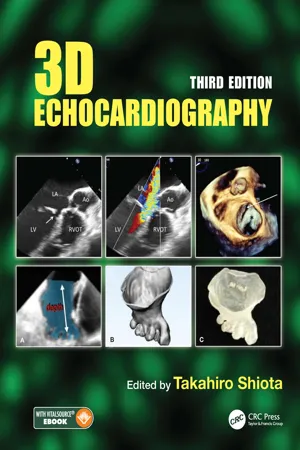1
Principles of 3D Echocardiographic Imaging
Introduction
Volumetric or three-dimensional (3D) imaging in echocardiography has grown rapidly in the last decades and has evolved from combining different two-dimensional (2D) acquisitions toward the true, real-time clinical systems we now have. While it has not completely replaced high-end 2D ultrasound scanners, rapid technical developments and its theoretical potential will make 3D echocardiography the modality of choice for clinical practice in the future.
This chapter discusses the principles underlying real-time 3D ultrasound imaging that are relevant for understanding the images and recognizing its potential and limitations.
First, the requirements of an imaging system used for cardiovascular applications are described, leading to the rationale behind 3D systems and sketching the properties needed for these systems to be useful in a clinical environment. Next, the technical properties of standard grayscale imaging, providing low-frame-rate 2D images, are described, after which these are extended to high frame rate, multiplane, and 3D imaging. Besides the acquisition of 3D information, there are several ways to visualize this, from multiplane over reslicing up to 3D rendering. Each of these has intrinsic advantages and disadvantages.
Requirements for Cardiac Imaging
In clinical practice, cardiac imaging serves several objectives. Mainly it is used to obtain relevant information and preferably quantification of cardiac and myocardial morphology, on cardiac function and on perfusion. When using echocardiography, the relevant morphological information extracted from the images translates into anatomical information on myocardium, pericardium, valves, and so on. For cardiac function, wall motion and deformation, valve function, and hemodynamics are studied, using visual assessment, myocardial strain imaging, and Doppler blood flow. Using additional contrast, some limited information on perfusion can be obtained.
In order to be useful, these parameters have to be efficiently visualized and preferably quantified. For this, there are some requirements on the images obtained. These include intrinsic image quality, with a sufficient temporal and spatial resolution, and appropriate tools for processing the data. With regard to spatial resolution, one would prefer this to be as high as possible in order to detect the smallest anatomical details. However, in some cases, for example, when evaluating cardiac function, or to guide interventions, it might be sufficient to have a resolution that is just enough for detecting clinically relevant information. In terms of myocardial function, a resolution cell about the order of magnitude of 1 cm3 seems appropriate, since smaller disease is not likely to be clinically relevant. However, keep in mind that it is important that this resolution is obtained everywhere within the myocardium. This figure is clearly not good enough when trying to evaluate the morphology of the valve and valvular apparatus and chordae. In this case, a submillimeter resolution would be more appropriate. This implies that there is no one unique definition for the required spatial resolution; it depends on the specific purpose of the information. Similar considerations can be made with regard to the temporal resolution. In the cardiac cycle, there are some very fast events, especially during the isovolumic periods, so a very high temporal resolution is needed if these are studied. This means that typically a temporal resolution of over 200 Hz is required. Given some of the intrinsic limitations in the processing of some derived parameters (like deformation), a frame rate of 200–300 Hz is thus desirable for quantification of myocardial motion and deformation. For visual interpretation of wall motion, 30 Hz would be sufficient since the human visual system is not able to discriminate faster-moving images. However, higher frame rates enable the images to be displayed in slow motion, thus enabling a better evaluation of events.
In order to assess and quantify the resulting images, the appropriate tools need to be available. Online quantification embedded in the ultrasound scanners is often complemented with an offline workstation, enabling more advanced visualization and quantification of the images (e.g., advanced 3D visualization and volume calculations, deformation analysis, etc.). For these, user friendliness is crucial in order to enable their use in a clinical environment, and approaches such as these using machine learning or artificial intelligence can improve the user experience, standardization of quantification, and speed of analysis.
Basics of Standard 2D Echocardiographic Imaging
Ultrasonic waves are longitudinal compression waves with a frequency above 20 kHz, as 20 kHz is the highest frequency detectable by the human ear. In cardiac imaging, typical frequencies used are 2 MHz for transthoracic imaging, 5 MHz for transesophageal imaging, and 30–40 MHz for intravascular applications. These base frequencies are often combined with harmonic imaging to improve the signal-to-noise ratio.
Ultrasonic waves are both generated and detected by a piezoelectric material. This kind of material deforms under the influence of an electric field, and vice versa, an electric potential is induced over the material by deforming it.
When an acoustic wave is generated by means of a piezoelectric material, it will propagate away from its origin in the medium with which the material is in contact. During propagation, the amplitude of the w...
